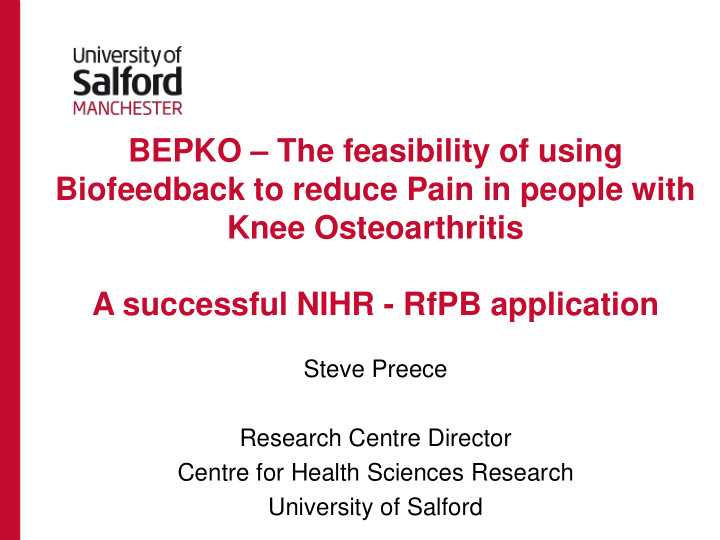



BEPKO – The feasibility of using Biofeedback to reduce Pain in people with Knee Osteoarthritis A successful NIHR - RfPB application Steve Preece Research Centre Director Centre for Health Sciences Research University of Salford
Outline of the session 1. Background to the study and proposed research 2. RfPB Funding stream 3. RDS support in developing the grant application 4. Developing the application 5. Reflections on the application process
Muscle activation patterns during normal walking The leg muscles activate in sequence to produce coordinated movement, such as walking
Muscle co-contraction during walking The quadriceps muscles extend (straighten) the knee The hamstring muscles flex (bend) the knee • Increased muscular co-activation observed in patients with knee osteoarthritis (OA) during the first 20% of the stance phase of walking.
The potentially damaging effect of muscle co-contraction in knee OA If the quadriceps and hamstrings work against each other for extended periods, this will increase the force at the knee joint. • Research now staring to show that elevated medial (inside) co- contraction accelerates cartilage loss in people with knee OA. • It also increased the likelihood of a total knee replacement at 5 years.
EMG biofeedback Electromyography (EMG) can be used to provide patients with visual information on activation patterns of specific muscle groups. EMG has been used successfully to change muscle activity in other condition, such as chronic neck pain, fibromyalgia, dystonia (muscle spasm) with good clinical outcomes.
Pilot work & previous research In developing the application we : a) Had evidence that EMG biofeedback had been used successfully to treat other MSK/neurological conditions b) Published a study on an alternative therapy (The Alexander Technique) showing reduced co-contraction was linked to good clinical outcomes c) Obtained pilot data from 5 patients on potential effectiveness of EMG biofeedback to reduce muscle activity d) Ran two separate focus groups with 4 patients and 4 physiotherapists. This was used to identify five key components of the intervention: Biofeedback software, Incremental training activities (ITAs), Instructional animations , Home practice component , Introductory video
Research for patient benefit (RfPB) “This programme is intended to support research which is related to the day-to-day practice of health service staff and is concerned with having an impact on the health or well-being of patients and users of the NHS. … Funded research projects are likely to fall into the areas of health service research and public health research”
Cost of proposal Tier 1: Research that has a clear and close trajectory to patient benefit. The programme has an upper limit of £350,000 (for up to 3 years) for research costs and any application needs to be within this limit. Tier 2: The programme receives many applications for feasibility studies towards trials and these would normally be expected to cost less than £250,000 though in exceptional circumstances, well argued in the application itself, they could cost more. Tier 3: The programme will also consider research that is on a pathway to patient benefit yet is further from it so long as it is appropriately costed. As a rule of thumb such research might be expected to cost less that £150,000.
RDS support workshop I attended RDS RfPB workshop in Sept 2016. Individual sessions on: 1. Research networks – how CRN support research 2. PPI – useful advice on how to develop PPI support 3. Health economics – useful to understand next stages 4. Statistics – sample sizes 5. Qualitative and mixed methods – encourage more formal qualitative evaluation of intervention 6. Healthy psychology/behaviour change – motivation to engage in proposed intervention 7. General bidding advice: 1. Go for tier 2: intervention development with feasibility trial 2. Get key academic staff onto the team
The research team 1. Dr Steve Preece – PI, biomechanics researcher (SRF) 1. Prof Nicki Walsh – Researcher in UCD & new interventions, UWE 2. Prof Richard Jones – Biomechanics researcher, Salford 3. Prof Anthony Jones – Rheumatologist, Manchester 4. Anita Williams – Qualitative researcher (reader), Salford 5. Dr Sarah Cotterill – Clinical trials expert/statistican, Manchester
Application Process • Stage 1 (Nov 2016) • PPI work done to develop application • Background (1000 words) , aims and full workplan (2500 words) • 5-6 week turn around • Stage 2 (March 2017) • Full application ~ 15,000 words! • Respond to reviewer concerns & extra details • Awarded (July 2017) • Reduce cost, Tier 3, intervention development only • Project started (April 2018) – Delay NIHR finances
Reflections on the application process • Get lead NHS partner on board as early as possible if work at university. • Read guidance very carefully – all 50 pages!!!! • Consult with the RDS an early and a later stage • If intervention development, then consider only Tier 3 funding. • Strengths of the application: • Big problem & clear benefit to NHS patients if intervention proves effectives • Experience/breadth of team & their input to the application
Reflections on the application process • Have full work plan perfected for stage 1. Only able respond to reviewer concerns in stage 2 not add extra details • Work plan is tight on space - clear message • Use web links for figures as Stage 1 application only text. • Be ready to respond and write stage 2 application in a relatively short timescale • Be prepare for a long timescale from idea conception to start of the project ~ 2 years.
Questions?
Recommend
More recommend